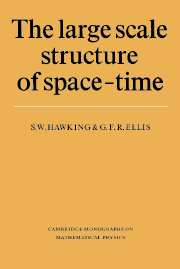Book contents
- Frontmatter
- Contents
- Preface
- 1 The role of gravity
- 2 Differential geometry
- 3 General Relativity
- 4 The physical significance of curvature
- 5 Exact solutions
- 6 Causal structure
- 7 The Cauchy problem in General Relativity
- 8 Space–time singularities
- 9 Gravitational collapse and black holes
- 10 The initial singularity in the universe
- Appendix A Translation of an essay by P. S. Laplace
- Appendix B Spherically symmetric solutions and Birkhoff's theorem
- References
- Notation
- Index
1 - The role of gravity
Published online by Cambridge University Press: 26 January 2010
- Frontmatter
- Contents
- Preface
- 1 The role of gravity
- 2 Differential geometry
- 3 General Relativity
- 4 The physical significance of curvature
- 5 Exact solutions
- 6 Causal structure
- 7 The Cauchy problem in General Relativity
- 8 Space–time singularities
- 9 Gravitational collapse and black holes
- 10 The initial singularity in the universe
- Appendix A Translation of an essay by P. S. Laplace
- Appendix B Spherically symmetric solutions and Birkhoff's theorem
- References
- Notation
- Index
Summary
The view of physics that is most generally accepted at the moment is that one can divide the discussion of the universe into two parts. First, there is the question of the local laws satisfied by the various physical fields. These are usually expressed in the form of differential equations. Secondly, there is the problem of the boundary conditions for these equations, and the global nature of their solutions. This involves thinking about the edge of space–time in some sense. These two parts may not be independent. Indeed it has been held that the local laws are determined by the large scale structure of the universe. This view is generally connected with the name of Mach, and has more recently been developed by Dirac (1938), Sciama (1953), Dicke (1964), Hoyle and Narlikar (1964), and others. We shall adopt a less ambitious approach: we shall take the local physical laws that have been experimentally determined, and shall see what these laws imply about the large scale structure of the universe.
There is of course a large extrapolation in the assumption that the physical laws one determines in the laboratory should apply at other points of space–time where conditions may be very different. If they failed to hold we should take the view that there was some other physical field which entered into the local physical laws but whose existence had not yet been detected in our experiments, because it varies very little over a region such as the solar system.
- Type
- Chapter
- Information
- The Large Scale Structure of Space-Time , pp. 1 - 9Publisher: Cambridge University PressPrint publication year: 1973



